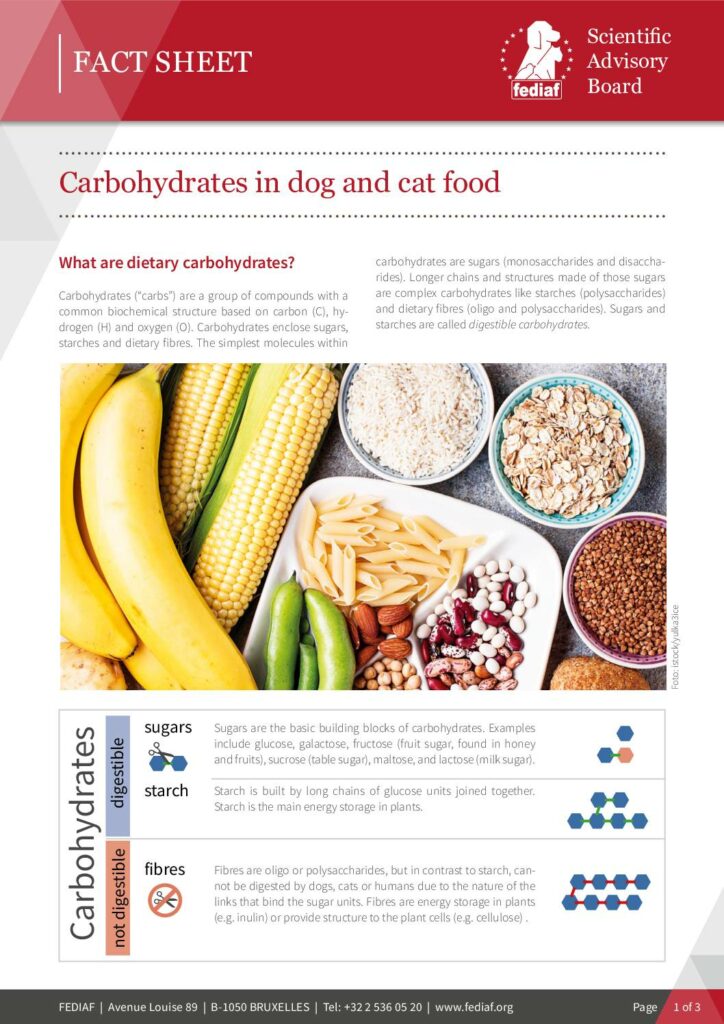What are dietary carbohydrates?
Carbohydrates (“carbs”) are a group of compounds with a common biochemical structure based on carbon (C), hydrogen (H) and oxygen (O). Carbohydrates enclose sugars, starches and dietary fibres. The simplest molecules within carbohydrates are sugars (monosaccharides and disaccharides). Longer chains and structures made of those sugars are complex carbohydrates like starches (polysaccharides) and dietary fibres (oligo and polysaccharides). Sugars and starches are called digestible carbohydrates.

What is the main purpose of digestible carbohydrates in pet foods?
Digestible carbohydrates are a direct source of glucose, an important source of energy for the body, and the main one for some tissues like the brain and red blood cells. When carbohydrate supply is limited, glucose can also be synthesised from proteins and other compounds.
Dogs and cats have the digestive enzymes necessary to break down digestible carbohydrates into sugar units, which can be absorbed in the small bowel. An exception is milk sugar, lactose, which is not adequately digested in adulthood by majority of dogs and cats and can cause gastrointestinal upset.
Starch also has important technological properties for dry kibble manufacturing, since its gelatinization is a crucial part of the extrusion process. (link to how pet food is made factsheets)
Please find more information here:
FEDIAF Expert Review – Carbohydrates
What about fibre?
Dogs and cats do not have the enzymes capable to break the linkages between sugars in fibre; therefore, fibre cannot serve as a direct source of glucose or energy to the animal. However, once fibre reaches the large intestine, it is fermented by the microbiota (mainly bacteria and yeasts) to provide energy to bacteria and large intestinal cells. The degree of fermentability varies depending on the fibre type.
Fibre has several benefits to pets. Some fermentable fibres known as prebiotic fibres promote the growth of beneficial intestinal microbiota which can help reduce harmful bacteria colonization. The fermentation products of fibre are beneficial to large intestinal cells. Non fermentable fibre promotes regular bowel movements and regulates faecal consistency. Moreover, since fibre provides almost no calories to the dog and cat, it can be used to deliver bulk and satiation for pets prone to weight gain.
Most pet foods use ingredients to provide a mixture of fermentable and non-fermentable fibres, offering the benefits of both fibre types.


What are the main sources of carbohydrates in pet food?
The common starch sources in pet foods are cereals (‘grains’), legumes and root vegetables. Starch needs to be well cooked to be properly digested and to prevent intestinal upset.
Fibre is provided by ingredients such as whole grains, purified cellulose, beet or chicory pulp, psyllium seeds, fruit and vegetable fibres, inulin and FOS (fructooligosaccharides).
Benefits of carbohydrates in pet food
Although not an essential nutrient, digestible carbohydrates provide an easy to use source of energy and glucose, which allows for the formulation of moderate fat diets and help with formulation of low-calorie diets to help manage weight problems. It also helps to spare the use of animal protein, which is a limited resource in pet nutrition and is associated with increased carbon footprint. Dietary fibre is not an essential nutrient either, but it has multiple benefits, such as promotion of a healthy intestinal microbiota, adequate intestinal transit, and satiation.
The main fibre and carbohydrates sources included in pet food also provide important essential nutrients such as vitamins, minerals and fatty acids.
The optimal digestible carbohydrate and fibre intake is going to vary from pet to pet. Please consult with your veterinarian or veterinary nutritionist to choose the best diet for your pet.
Are carbohydrates reported on the pet food label?
EU law determines the mandatory minimal nutritional information on the pet food label, listed under the heading “analytical constituents” as grams per 100 grams of food as fed (%). This includes protein (or crude protein), fat (or crude fat), inorganic matter (or crude ash) and crude fibre; but does not include digestible carbohydrates. The crude fibre value on the label is the result of chemical analysis which underestimates the total dietary fibre content of the diet; the fibre content in the product is typically higher than reported. For more detailed information about the carbohydrate content of a specific pet food, contact the manufacturer.
